More than half of Americans now use digital payment apps more than traditional methods, and a growing number of them are effectively using these digital wallets in place of bank accounts. Some of the most popular apps include Venmo, Cash App, Chime, Current, Acorns, and Varo to name a few.
Nonetheless, while payment apps tend to offer a more streamlined user experience and lower fees, they aren’t afforded the same degree of protections as conventional banking institutions. And it’s becoming a problem, as exemplified by the collapse of Synapse Banking Technologies in 2024, which left millions of dollars in limbo. Furthermore, the effects were felt far and wide due to Synapse’s integration with several popular third-party apps.
While Synapse’s bankruptcy prompted US regulators to bring fintechs under greater oversight, variations in consumer protections remain. Also, many fintech apps lack direct coverage from the Federal Deposit Insurance Corporation (FDIC), meaning that customers aren’t adequately protected against financial loss in the event of the organization behind the fintech app going bankrupt.
In light of the concerns, the Consumer Financial Protection Bureau (CFPB) recently issued a final rule to supervise digital payments and wallets. However, with Donald Trump expected to loosen regulations, there is some doubt on the rule’s future. While this may make it easier for fintechs to expand their service offerings, it may also erode trust in payment apps, especially if 2025 sees any further disasters like the Synapse case.
Chartered banks continue to provide an as-yet unrivalled level of protection for consumers’ financial assets, even if they generally don’t offer the convenience or lower fees of modern payment apps. For consumers, this means it’s vital to carefully consider the risks and balance them with the advantages. For instance, more risk-aware consumers tend to transfer money out of their digital wallets shortly after they receive new funds.
The FDIC – as well as similar bodies in other countries – only insure funds held in chartered banks, and that’s unlikely to change in the near future. As such, money is only safe being held in a nonbank if it’s a reputable company and has more assets than liabilities. Moreover, some nonbanks may close consumers’ accounts without notice. Others, due to technical issues, can make it difficult – or even impossible – to withdraw funds to certain bank accounts.
For fintechs, the shift in consumer expectations and potential of further regulatory oversight means that now is a good time to consider partnering with traditional banks. Trust is also a major competitive differentiator, encouraging fintechs to offer protections that are equivalent – if not better than – FDIC insurance.
.png?width=1816&height=566&name=brandmark-design%20(83).png)



